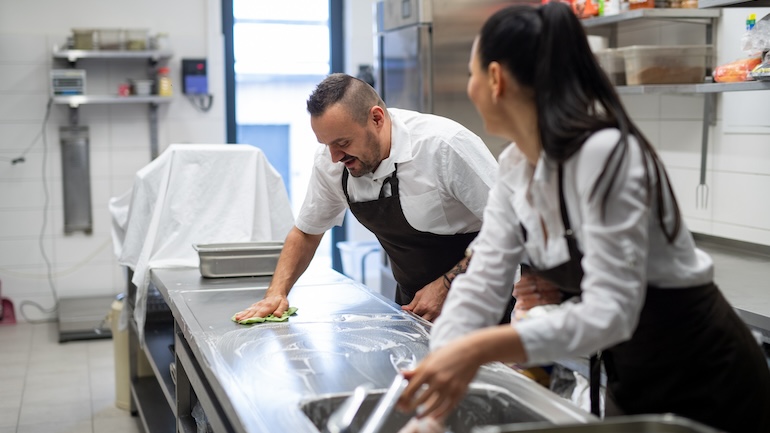In diners’ eyes, delicious food and a spotless kitchen should go hand in hand. In fact, cleanliness matters more than anything else. American diners listed a recent health inspection warning as the top factor that would deter them from visiting a restaurant – which means if restaurant kitchen cleaning has taken a back seat at your venue lately, it’s time to whip out the rubber gloves.
In this restaurant deep cleaning guide, we’ll cover:
- Daily, weekly, and monthly cleaning tasks for the back of house
- Daily, weekly, and monthly cleaning tasks for the front of house
- 8 common commercial kitchen cleaning questions
Ready to make your restaurant sparkle? Let’s go.
Back of House Cleaning Checklist
Restaurant cleaning can run like clockwork with the right kitchen cleaning schedule. Since several tasks need to be done daily, while others only need to be done monthly, using a restaurant cleaning checklist that breaks down tasks by time period is your best bet.
Daily Cleaning Tasks
- Clean and sanitize all food prep areas multiple times a day
- Clean stovetop and change foil lining
- Clean fryer
- Wash all tableware
- Restock hand washing station with soap and paper towel
- Clean sinks
- Put towels and aprons in laundry and restock with fresh ones
- Sweep fridges and storage rooms
- Sweep/mop floor and take out trash at closing time
- Disinfect food disposal area and trash cans
- Wipe down kitchen equipment like toasters and microwaves
- Wipe down walls
- Clean and sanitize countertops and tables in staff break room
- Clean and sanitize staff restrooms
Weekly Cleaning Tasks
- Clean and sanitize fridges and freezers
- Throw away old ingredients
- Clean ovens and change fryer oil
- Clean floor drains by flushing them out
- Wash walls
- Vacuum back office floor
Monthly Cleaning Tasks
- Clean grease traps
- Dust fridge coils
- Clean and sanitize ice machine and freezer
- Clean light fixtures
- Deep clean staff break room and back office

Download our restaurant cleaning checklist for front of house and back of house cleaning.
Front of House Cleaning Checklist
Now that you’ve got a robust restaurant kitchen cleaning checklist, let’s look at front of house upkeep – including a bar cleaning checklist to keep the heart of your venue shining bright.
Daily Cleaning Tasks
- Disinfect and clean tables and chairs between seatings
- Disinfect and clean menus, condiments, and credit card readers after every use
- Wipe down bar multiple times a day
- Wipe high-touch areas like door handles several times a day
- Wipe down glass doors to remove fingerprints
- Check restrooms every few hours to ensure they’re clean; if they’re not, clean them immediately, and if they are, scrub them thoroughly once a day at minimum
- Clean garnish trays and soda stations at closing time
- Clean and plug beer taps
- Empty rag buckets at server station
- Empty and clean coffee makers
- Polish glasses and roll silverware
- Vacuum or sweep/mop floor and taking out trash at closing time
Weekly Cleaning Tasks
- Flush keg lines and clean coffee machines
- Wipe down walls and furniture legs
- Dust picture frames, window sills, and baseboards
- Refill restaurant sanitizer stations near high-traffic areas
Monthly Cleaning Tasks
- Clean light fixtures, ceiling fans, and decor
- Shampoo carpets and upholstered furniture

Use this customizable bar cleaning checklist to keep your restaurant bar looking spotless.

Common Restaurant Kitchen Cleaning Questions
With a restaurant cleaning checklist for the back and front of house, you know what you need to clean. And with a kitchen cleaning schedule, you know when to do it – and when a restaurant deep cleaning is required. However, you may not know how to clean a commercial kitchen just yet.
Especially if you have newer kitchen staff, they might not be sure of certain specifics, like how to clean a grease trap in a restaurant. So, let’s dive into the answers to your most pressing commercial kitchen cleaning questions. When in doubt, you can always call in a restaurant kitchen cleaning professional to help you get the job done.
How Do You Sanitize a Restaurant Kitchen?
Sanitizing takes restaurant kitchen cleaning one step further. The purpose? To eliminate bacteria and viruses that can spread and cause foodborne illness.
To do this properly, you’ll want to sanitize all kitchen surfaces and equipment. The United States Environmental Protection Agency’s (EPA) website has a list of more than 600 cleaning products you can use. Be sure to check how long each cleaning product needs to sit on a surface in order to sanitize the area. Don’t forget to ask your staff to use hand sanitizer, too.
Can You Use Bleach in a Restaurant Kitchen?
The short answer: yes! Bleach should be a go-to item on your restaurant kitchen cleaning checklist.
Add about one tablespoon of bleach per gallon of water – that’s the maximum recommended concentration for food contact surfaces. For stronger solutions, be sure to rinse the surface with drinkable water after sanitizing. A contact time of one to five minutes should be enough to get the job done, depending on the concentration and surface type.

Use this template to align your team on key proesses and streamline daily operations.
Is Steam Cleaning Safe for Commercial Kitchen Equipment?
Steam cleaning is safe and effective, which means it’s key to knowing how to clean a commercial kitchen. The best part? You don’t have to use any harsh chemicals.
Dry vapor steam cleaning kills 99.99% of bacteria, wipes away grease, odors, and stains, and gets into the tight spots in your kitchen that you can’t reach with regular cleaning. You can steam clean food prep areas, ovens, fryers, vents, range hoods, sinks, floors, and more.
How Do You Clean a Grease Trap in a Restaurant?
First, wait until after hours – this job can be smelly. You’ll also want to grab rubber gloves and safety goggles. When you’re ready to begin, run cold water in the sink above the trap to help its contents harden, then turn off the water.
Next, remove the lid and scoop out the floating grease and solid waste. Clean up the remaining wastewater and use a scraper to clean the walls and bottom of the trap, then rinse everything off. Make sure to dispose of the waste properly. And that’s how to clean a grease trap in a restaurant!

Download our restaurant cleaning checklist for front of house and back of house cleaning.
How Do You Clean a Restaurant Deep Fryer?
A dirty deep fryer can cause cross-contamination, and a buildup of grease can lead to costly repairs. So, it’s essential to clean your fryer regularly.
To start, make sure the deep fryer is turned off and cooled down. Then, drain and clean the fryer wells, clean the drain lines, scrub the fryer’s inside surfaces with an eco-friendly cleaner, and sanitize the baskets. Give everything a good rinse before putting it all back.
How Do You Clean a Restaurant Kitchen Grill?
Cleaning your kitchen grill is a daily task necessary to prevent foodborne illness, so you’ll want your staff to know it well. Here’s what to do.
Get the grill sizzling by heating it up and pouring a cup of cooking oil over the surface. Use a pumice stone or griddle brick to gently scrub in small circles. This will wipe away bits of food and grease. Next, splash half a cup of vinegar on the grill to lift any stubborn grease and stains. Finish with a rag soaked in cooking oil for a shiny, polished surface that’s ready for action.
How Do You Clean a Commercial Kitchen Oven?
Oven racks can easily get covered in burnt food, which can negatively affect the taste of your dishes – or worse, can be a fire hazard.
To clean your oven, start by removing the racks and brushing off excess food. Then, soak and scrub the racks, sanitizing them with a non-toxic cleaner. Next, use vinegar and baking soda to scrub the oven’s interior. Once the racks are dry, pop them back in. Here’s to safer cooking and better flavors!
How Do You Clean a Restaurant Kitchen Exhaust Hood?
Exhaust hoods keep your kitchen safe by blowing out smoke, odors, and excess heat, but they need regular attention to stay working their best. It’s a smart move to call a pro for this piece of kitchen equipment, but if you want to clean it yourself, here’s how.
First, turn off and cool down the grill, and disassemble the exhaust hoods and filters. Now it’s time to degrease everything and clean the ducts. Finally, check the fan belts to see if they’re worn down, and if so, replace them before reassembling the hood.

Use this customizable bar cleaning checklist to keep your restaurant bar looking spotless.
You’ve just gotten a crash course in restaurant kitchen cleaning. Delicious food? Check. Spotless kitchen. Check. Bring on the customers!
Download our free inventory template
Sign up for our free weekly TouchBistro Newsletter







